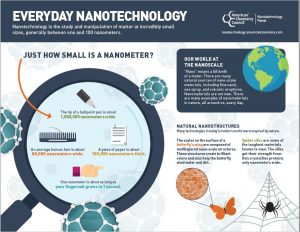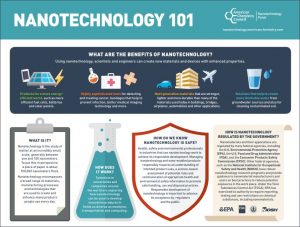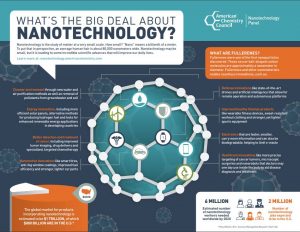 Nanoscale materials are extremely small pieces of matter with at least one dimension between 1-100 nanometers, or a billionth of a meter. To put the nanoscale in perspective, a human hair is approximately 80,000 nanometers wide, and a sheet of paper is about 100,000 nanometers thick.
Nanoscale materials are extremely small pieces of matter with at least one dimension between 1-100 nanometers, or a billionth of a meter. To put the nanoscale in perspective, a human hair is approximately 80,000 nanometers wide, and a sheet of paper is about 100,000 nanometers thick.
What Makes These Tiny Particles Interesting?
At the nanoscale, some substances may exhibit new and novel properties one wouldn’t predict from larger forms. For example, some substances may be better at conducting electricity or heat at the nanoscale than they are at larger sizes. Other properties that might change in unexpected ways could include things like magnetism and light absorbance. These are just some examples of the properties that have scientists in government, academia, and industry exploring ways to use nanomaterials to tackle critical technology challenges in energy storage, water purification, and health care, among others.
 The U.S. Environmental Protection Agency (EPA) is Also Interested in Nanoscale Substances
The U.S. Environmental Protection Agency (EPA) is Also Interested in Nanoscale Substances
In 2017 EPA finalized a one-time reporting rule for nanoscale materials (40 CFR 704.20). EPA is interested in understanding the extent of nanoscale materials in commerce, particularly those that may exhibit new and novel properties. The agency says the information generated through the reporting process will help it determine whether any further action is needed under the Toxic Substances Control Act, including, but not limited to, additional information requests on specific substances or uses.
Part of the rule requires companies to conduct a 3-year lookback encompassing the period August 14, 2014-August 14, 2017 and report certain information on nanoscale materials manufactured, imported, or processed during that period by August 14, 2018. Examples of the types of information EPA wants include production volumes, manufacturing and processing methods, information about exposure potential, health and safety data, and physical and chemical properties. The rule does not require companies to generate new data.
The rule contains many terms and concepts that have not been used in previous TSCA rules, such as “discrete forms” and “new and novel properties.” Understanding those elements of the rule and how they relate to one another can be critical for determining whether a company has an obligation to report.
Understanding EPA’s Rule
To help companies better understand their potential reporting requirements, the ACC Nanotechnology Panel has developed a flowchart that presents a set of ordered questions to help companies understand the numerous definitions and exceptions in the rule. In addition to familiar “Yes” and “No” options typically seen in flowcharts, this flowchart also includes pathways to follow when information is neither known nor reasonably ascertainable, an important factor in determining whether a reporting obligation may exist. The flowchart is provided as guidance only, and nothing in it is intended to constitute legal advice. You can find the flowchart at this link on the panel’s public website. EPA guidance, forms, and instructions for reporting are available from EPA.
Guiding the Responsible Development of Nanotechnology
 Using nanotechnology, scientists and engineers can create new materials and devices with enhanced properties. From creating products for a more energy-efficient world, to developing highly sophisticated tools in the medical field, to making the next generation of materials that are stronger, lighter, and more durable, as well as providing solutions that help create more drinkable water, nanotechnology enhances many products people use every day. That is why the ACC Nanotechnology Panel is at the forefront of guiding the responsible development of nanotechnologies domestically and internationally and providing a scientifically sound approach to nanotechnology policy.
Using nanotechnology, scientists and engineers can create new materials and devices with enhanced properties. From creating products for a more energy-efficient world, to developing highly sophisticated tools in the medical field, to making the next generation of materials that are stronger, lighter, and more durable, as well as providing solutions that help create more drinkable water, nanotechnology enhances many products people use every day. That is why the ACC Nanotechnology Panel is at the forefront of guiding the responsible development of nanotechnologies domestically and internationally and providing a scientifically sound approach to nanotechnology policy.
To learn more about the Nanotechnology Panel or to inquire about joining the panel, contact Jay West at [email protected].